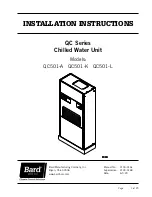
English
34 SysAqua
17.2. PERIODIC TABLE OF SERVICE AND MAINTENANCE
TASKS PER COMPONENTS
ACTIONS
1
month
3
months
6
months
12
months
24
months
Recommended inspection and maintenance
interval
1 - Casing
1.1
Control possible contaminations, damage
and/or corrosion.
Clean and repair if required.
1.2
Check the possible presence of water
(condensates, leakages,...).
Clean and look for the cause, then
repair.
1.3
Verify thermal insulation aspect
Replace if required.
1.4
Check the state of the anti-vibration pads
Replace if required.
1.5
Check the condition of door gasket.
Replace if required.
At each inspection
2 - REFRIGERANT CIRCUIT
2.1
Verify oil compressor level when
compressors are off
2.2
Check the lack of gas bubbles in the fluid
line
2.3
Check the lack of humidity in the
refrigerating fluid
2.4
Check the pipes or capillaries do not rub and
vibrate.
2.5
Check the compressors do not emit
abnormal noise or vibration.
2.6
Check the backflow temperature.
2.7
Record the operating pressure
Check it is above or below those
recorded when the unit was started
up.
2.8
Check the compressor fastening screws are
tight.
2.9
Check the crankcase heater are powered on
during the stop cycle.
2.10
Check the cleanliness of the coil.
Clean if required
.
2.11
Test the oil for contamination.
Change the oil if required.
2.12
Check the filter drier clogging.
Replace if required
2.13
Check the operation of the high pressure
switch.
Replace if required
2.14
Check the lack of refrigerating fluid leak
( détecteur si nécessaire)
Repair
2.15
Check the cycle reversal valve
2.16
Check the condition of the anti-vibration
studs
Replace if required
3 - HYDRAULIC CIRCUIT
3.1
Check the state of the function, check there
is no damage nor corrosion.
Clean and repair.
3.2
Check the condition of the exchanger, in
terms of corrosion and functionality.
Clean and repair.
3.3
Check the tightening of the pipe
connections and fastening
Readjust and repair if necessary.
3.4
Verify the pressure value of the hydraulic
circuit
3.5
Bleed the air.
3.6
Run the isolation valves
3.7
Check there is no ice set.
3.8
Check the state of the piping thermal
insulation.
Repair and replace if required.
3.9
Check the frost protection devices (glycol-
based water, thermostat, …).
Repair and replace if required.
When air temperatures are wintery,
and after general stoppage of the
installation, the water contained in
the plate exchanger may freeze.
To prevent such problems, fully
drain the unused plate exchanger or
protect it by pouring an antifreeze
solution into the hydraulic circuit or
other devices.
The manufacturer waives any
liability for damage to the plate
exchanger caused by water freezing
inside the unit.
Whenever there is a risk of freezing
















































